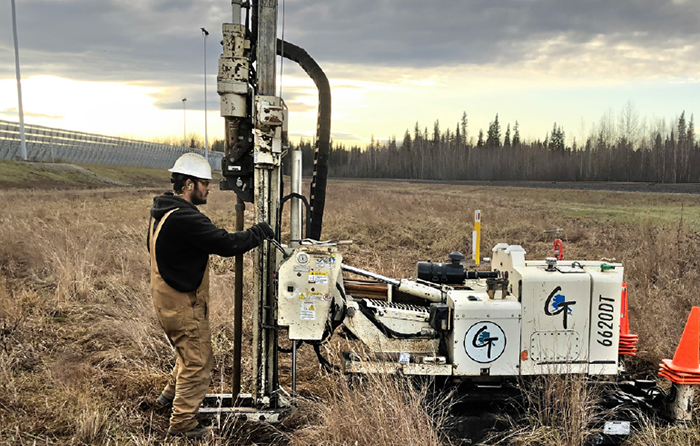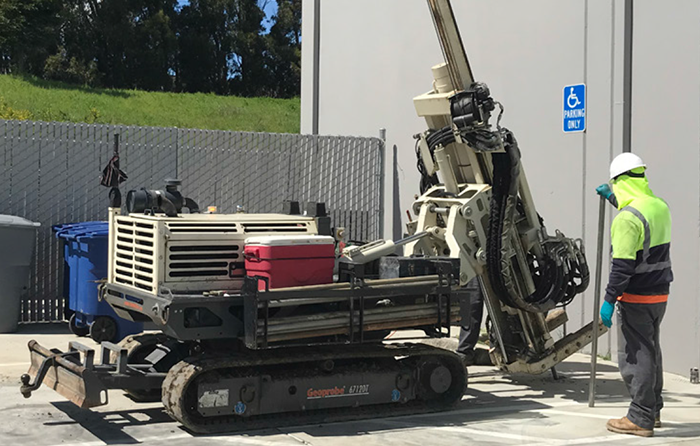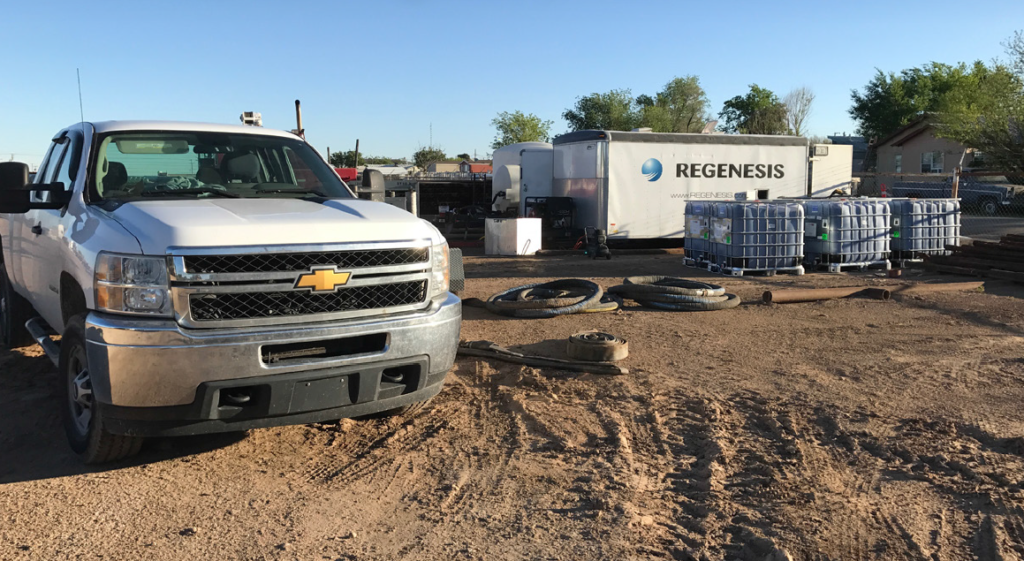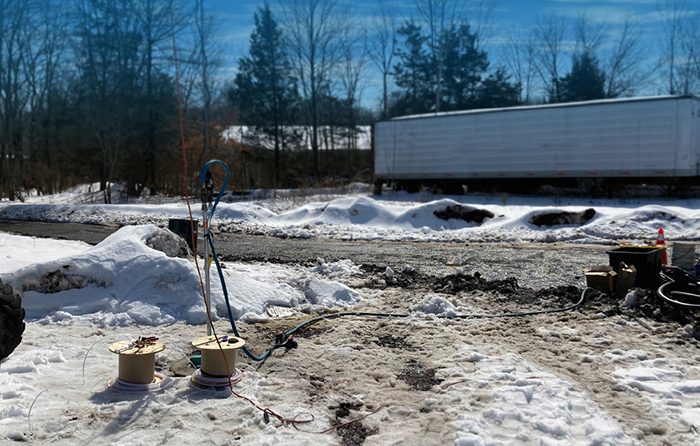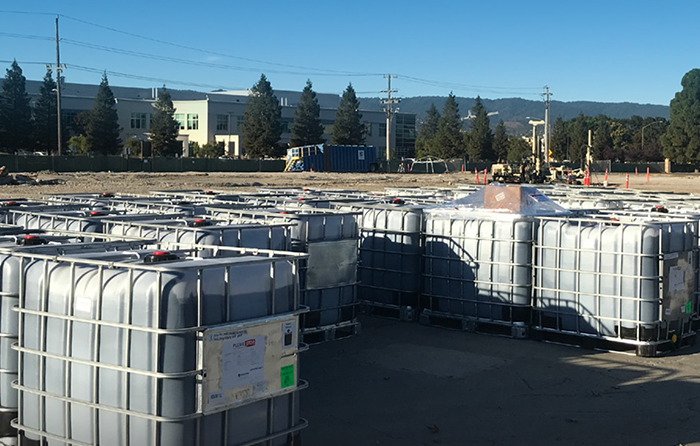PlumeStop Successfully Remediates PFAS at Alaska Airport
This case study reviews a site where PlumeStop® Colloidal Activated Carbon was applied to treat PFAS resulting from aqueous film-forming foam (AFFF) usage at an airport facility in Alaska. The application has reduced the five targeted PFAS below detection limits and applicable cleanup levels in a challenging hydrogeologic environment over a sampling period now approaching two years. In 2017, Fairbanks International Airport began an investigation in collaboration with the Alaska Department of Environmental Conservation and the Fairbanks office of Shannon & Wilson, a leading Pacific Northwest-based environmental consulting firm, to investigate the extent of PFAS migration from the site. Shannon & Wilson engaged REGENESIS for a pilot test plan to remediate one of the identified AFFF release areas, following successful treatments demonstrated at other sites.
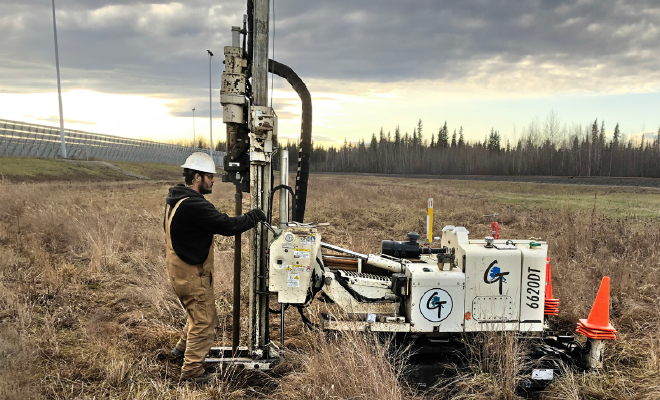
Case study highlights:
- Targeted PFAS contaminants remediated to below detection limits at airport site
- Challenging environmental conditions overcome for a successful PFAS source zone treatment
- PlumeStop application has completely remediated the five individual PFAS targeted, reducing concentrations from 1,200 ng/L to non-detect
7m 31s reading time
98% PCE Reduction Achieved After 16 Months
The site is a former dry-cleaning supply distribution business that operated from 1957 to 2000. The former facility provided laundry chemicals, including detergents and spotting chemicals, packaging products such as hangers and polyethylene bags, and bulk deliveries of tetrachloroethene (PCE). Remediation at the site was completed in two primary phases. The first phase was a targeted excavation and soil mixing event focused on addressing the highly impacted shallow soils and smear zone. The second phase was focused on treating the groundwater PCE plume onsite and preventing further plume migration offsite.
Case study highlights:
- High PCE concentrations were detected in soil and groundwater during a site investigation
- A pragmatic, phased approach was used to target PCE in soil and groundwater
- The multi-component treatment was immediately effective and has maintained 98% PCE reduction in onsite groundwater
4m 23s reading time

Site Closure Achieved: Sustainable Remediation of PFAS at New York Refinery
Green, Sustainable Remediation Reduces Cost and Environmental Impact
A 25-acre former refinery located in a mixed-use industrial/commercial area in New York was contaminated with PFAS. Benchmark & TurnKey, a leading engineering and redevelopment consulting company, engaged REGENESIS for an in situ remedy that would effectively and economically cut off the groundwater plume and prevent migration of PFAS offsite.
The site was entered into the New York State Department of Environmental Conservation’s (NYSDEC’s) Brownfield Cleanup Program (BCP) to facilitate its commercial redevelopment. Remedial alternatives were evaluated for a comprehensive site closure strategy, and approaches were scored based on NYSDEC’s Green Remediation Policy Document (DER-31), which considers the “environmental impacts of treatment technologies and remedy stewardship over the long term.”

Case study highlights:
- Brownfield cleanup program’s green remediation policy leads to PlumeStop for PFAS treatment
- Skilfully managed PlumeStop application achieves sustainability and cost reduction objectives
- NYSDEC confirms cleanup requirements have been achieved, making the site eligible for redevelopment
8m 45s reading time
PFAS Eliminated for 3.5 Years and Counting
This case study reviews a pilot test to remove PFAS risk via an in situ colloidal activated carbon barrier at Camp Grayling in Crawford County, Michigan, a large year-round military training center operated by the Michigan Army National Guard (MIARNG).
Colloidal activated carbon was selected because of the expected rapid reductions of PFAS by removal from the dissolved mobile phase, as well as its expected lower total project costs when compared to operating a mechanical system over a similar time. The MIARNG decided to conduct a PlumeStop pilot test to determine if this treatment would meet their site goals prior to a possible full-scale application. The goals for this pilot project were to utilize an approach that could both protect the Grayling community from exposure and cost-effectively expand to a full-scale application.
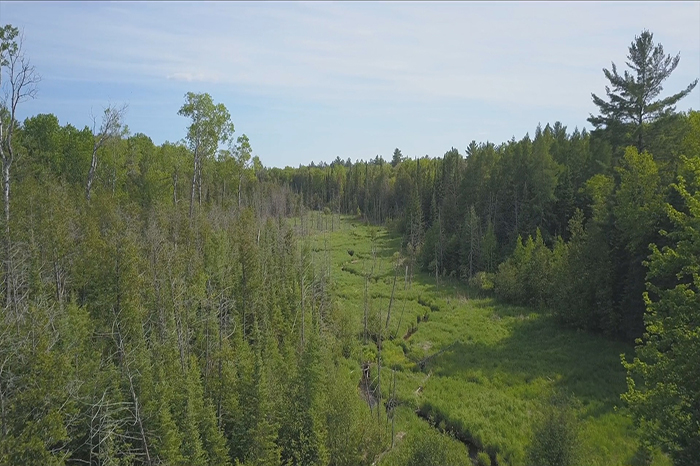
This case study features the following:
- Results 3.5 years post-application show PFAS and PCE reduced to non-detect
- New, innovative approach using an in situ colloidal activated carbon barrier to eliminate PFAS exposure pathway and protect the community
- Collaborative effort amongst various State of Michigan and military departments
- Economical and effective pilot study design
8m 59s reading time
Treatment of a widespread plume beneath Bologna city centre in Italy
A widespread plume of chlorinated solvents (CHC) has been monitored for more than a decade underneath the train station and extending out under the surrounding urban area of Bologna, Italy. The intention on this site was to treat all of the accessible ‘hot spots’ present within the plume, with the first area being used as a pilot test to confirm dose and distribution.Read More
PlumeStop Barrier Protects Drinking Water Supply Wells
This case study reviews a former chemical manufacturing facility in Texas where PlumeStop® Colloidal Activated Carbon was used in a permeable reactive barrier (PRB) to halt the movement of chlorinated solvents in groundwater. EA Engineering, Science, and Technology, Inc., PBC, a leading multi-disciplinary environmental and engineering consulting firm, contracted REGENESIS to implement the solution. PlumeStop was to be applied as part of an in situ bioremediation PRB near the distal end of the plume to promote sorption-enhanced natural attenuation of the contaminants.

Case study highlights:
- Innovative remedial approach addresses large PCE plume at a bedrock site under the CERCLA-Regulatory Framework
- Substrates successfully addressed contaminants in the Ogallala Sandstone
- PlumeStop PRB successfully cut off PCE and chlorinated solvent daughter products and prevented further movement downgradient toward private water supply wells
9m 46s reading time
DNAPL to Non-Detect: 6 Orders of magnitude reduction of chlorinated solvents
Combined in situ sorption and biological degradation leads to site closure of large manufacturing site in Northern Italy
Chlorinated solvents were used for many years at a former manufacturing facility in Northern Italy. This resulted in contamination of the groundwater underlying a large proportion of this 60,000 m2 site. Groundwater concentrations of up to 155,000 μg/L TCE meant there was a suspected presence of Dense Non Aqueous Phase Liquid (DNAPL) on parts of the site. The contamination posed an unacceptable risk to both on- and off-site receptors and it was determined that active remediation was required on a large proportion of the site.
Remediation Strategy:
REGENESIS created a strategy comprising Enhanced Reductive Dechlorination (ERD) tailored to contaminant concentrations and local geology, across the entire impacted area. This strategy was coupled with an injectable Permeable Reactive Barrier (i-PRB) at the site boundaries. This in situ remediation approach proved to be successful, leading the site to closure after having reached stably very stringent concentrations (VC<0.5 μg/l; TCE<1.5 μg/l) and obtaining up to 6 orders of magnitude reduction in concentrations.
Suite of REGENESIS products applied for ERD: 3-D Microemulsion®, HRC®, HRC-X®, HRC Primer®.
Injectable Permeable Reactive Barrier : PlumeStop®Liquid Activated Carbon™ (CAC)
6m 30s reading time
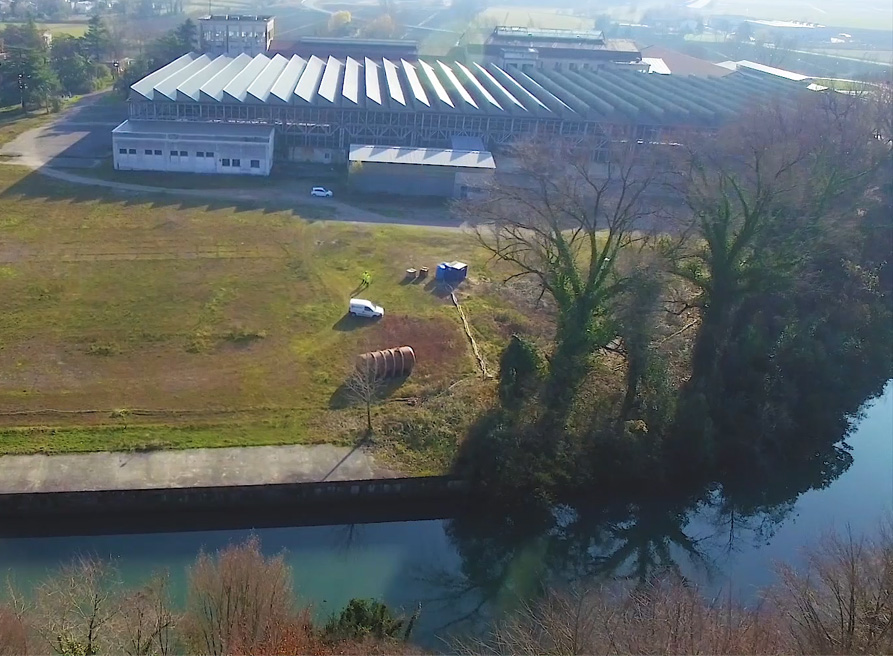
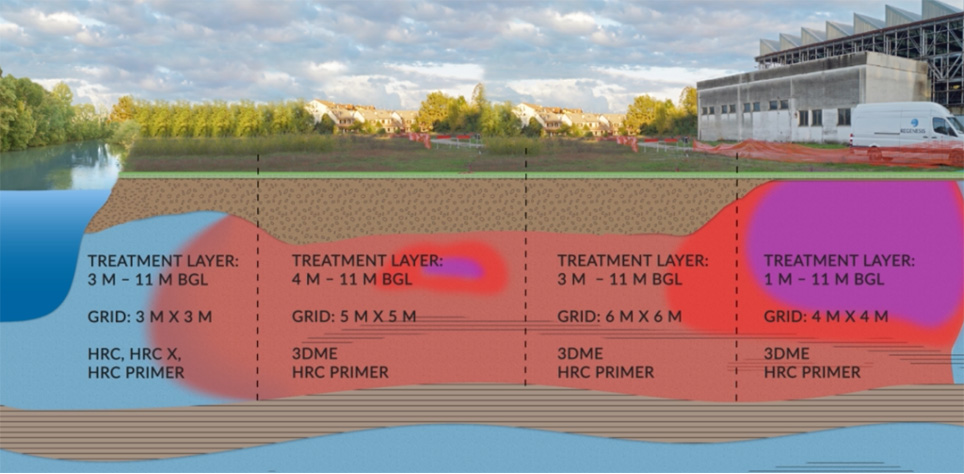
PFAS Removal from Aquifer at Hazardous Site Where AFFF Was Used
This case study reviews an ongoing Pennsylvania Hazardous Site Cleanup Act (HSCA) project where aqueous film-forming foam (AFFF) extinguished a large fire in the 1980s was the target of an innovative pilot study to address per- and polyfluoroalkyl substances (PFAS).
Working closely on behalf of the PADEP, Tetra Tech, a leading provider of consulting, engineering, and technical services worldwide, was principally involved in assessing the options and choosing a technology for the pilot test. This effort led to the decision to conduct a pilot study using PlumeStop®, a patented colloidal activated carbon amendment known to eliminate the risk of PFAS.
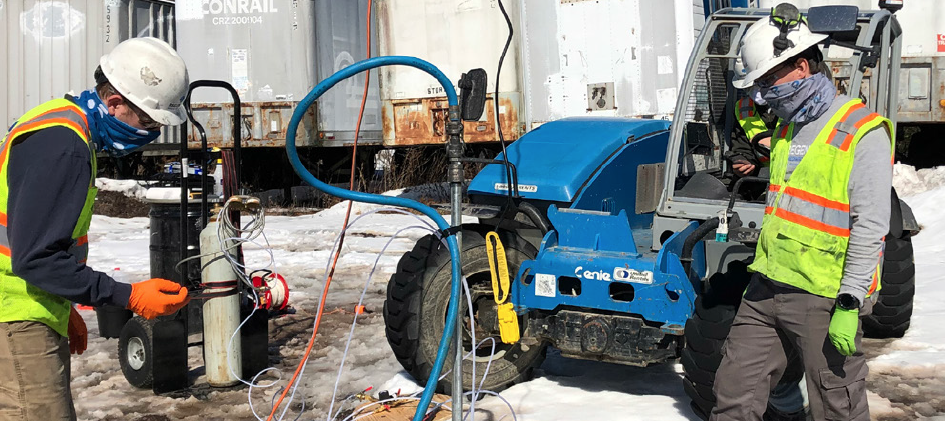
Case study highlights:
- Total PFOS and PFOA reduced from 91,400 to <50 ng/L in one month
- Injection testing effectively used for design confirmation in PlumeStop PFAS remediation pilot study
- Application included innovative injection using straddle packer system to isolate vertical zones
8m 46s reading time
Injectable permeable reactive barrier stops MTBE and benzene plume
Pilot-scale application of PlumeStop and ORC Advanced in the form of an injected permeable reactive barrier proves an effective solution to a long plume under a residential property in Belgium. Full-scale treatment has been scheduled.Read More
PlumeStop and S-MicroZVI Application Paves The Way For Redevelopment
Case study highlights
This case study reviews a contaminated chlorinated solvent site in northern California, USA, where advanced design verification testing and predictive modeling methods were used to guide a remarkably successful in-situ remediation effort:
-
Highly successful remediation solution using colloidal technologies: PlumeStop and S-MicroZVI
-
Complete reduction of PCE, TCE and daughter products in the treatment areas
-
Flux-based predictive modeling used to optimise remediation to meet two-year timeline
-
Remedial objectives achieved allowed redevelopment of the property


 Americas
Americas Europe
Europe Français
Français Deutsch
Deutsch Italiano
Italiano Español
Español